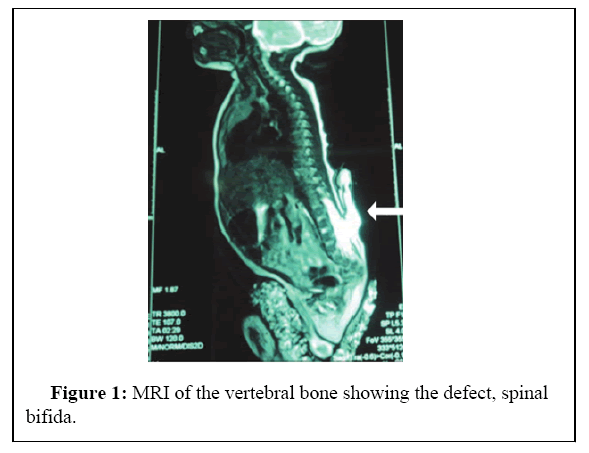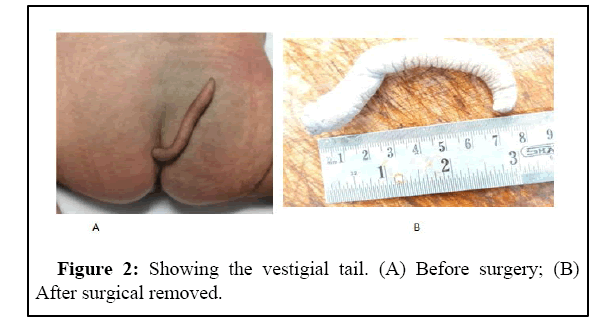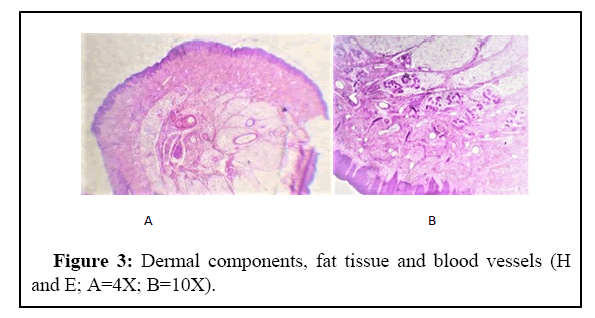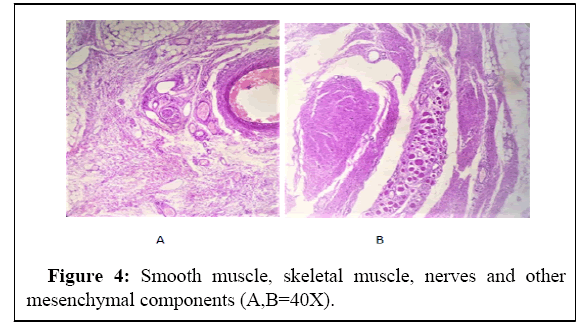Human Tail in a New Born: A Case Report
Received: 31-Aug-2022 / Manuscript No. JCEP-22-72965 / Editor assigned: 02-Sep-2022 / PreQC No. JCEP-22-72965 (PQ) / Reviewed: 23-Sep-2022 / QC No. JCEP-22-72965 / Revised: 03-Oct-2022 / Manuscript No. JCEP-22-72965 (R) / Published Date: 19-Oct-2022 DOI: 10.4172/2161-0681-22.12.417.
Abstract
Background: Human tails are rare congenital anomalies protruding from midline of the lumbosacral region covered by skin. Human tails are classified as true tail and pseudo tail. True tails, also known as vestigial tails are caudal, midline protrusion capable of spontaneous or reflex motion, consisting of skin covering with a combination of striated muscle, adipose and connective tissue, normal blood vessels and nerves.
Case presentation: A 47 days old female infant born from 28 years old prime parous women present with cutaneous appendage arising from the sacrococcygeal region, in the midline, above the intergluteal cleft. The tail-like structure was 9 cm in length, with a diameter between 3 cm and 2 cm in all its length, cylindrical, and pointy towards the end. The structure was soft, covered in skin, it shows spontaneous movement. The MRI report shows S1- S2 level spinal bifida.
Conclusion: This is a rare case of vestigial human tail with spinal Bifida on 47 days old female infant born from prime parous mother through spontaneous vaginal delivery diagnosed by histopathologic examination.
Keywords: Human tail; Vestigial tail; Pseudo-tail; Spinal bifida
Introduction
Human tails are rare congenital anomalies protruding from midline of the lumbosacral region covered by skin [1,2]. The birth of a baby with a tail can cause psychological disturbance to the parents and, in some cases, a feeling of stigma and shame [3,4].
Human tails are classified as true tail and pseudo tail. True tails, also known as vestigial tails are caudal, midline protrusion capable of spontaneous or reflex motion, consisting of skin covering with a combination of striated muscle, adipose and connective tissue, normal blood vessels and nerves. Pseudo tail is a secondary protrusion caused by various anomalies or neoplasms such as, anomalous prolongations of coccygeal vertebrae, occult spinal dysraphism, lipoma, teratoma, a parasitic fetus, fibro lipoma [4-6]. Unlike the tail of other vertebrates, human tails do not contain vertebral structures [3,4].
Human tail can be associated with congenital anomalies such as spinal dysraphism, which should be intentionally assessed before any extirpation attempt [5]. Thorough neurological examination and imaging studies of the vertebral column are recommended to exclude this possibility. Spina bifida to be the most frequent coexisting anomaly with both true tail and pseudo tail [7,8].
Case Presentation
A 47 days old female infant born from 28 years old prime parous women having regular antenatal follow up, with spontaneous vaginal delivery and no history of radiation or chemical exposure during the pregnancy, was referred to Jimma University medical center with referral diagnosis of vestigial human tail.
Upon examination a cutaneous appendage was found, arising from the sacrococcygeal region, in the midline, above the intergluteal cleft. The tail-like structure was 9 cm in length, with a diameter between 3 cm and 2 cm in all its length, cylindrical, and pointy towards the end. The structure was soft, covered in skin, and shows spontaneous movement. The MRI report shows S1-S2 level spinal bifida (Figure 1).
Surgery was done with removal of the whole structure and sent to pathology department. The gross structure shows tail-like structure was 9 cm in length, with a diameter between 3 cm and 2 cm in all its length, cylindrical, and pointy towards the end (Figure 2).
On microscopy it shows keratinized stratified squamous epithelium containing the underlining sweat gland hair follicles and other dermal structure, skeletal muscle, smooth muscles, nerve bundles, adipose tissue, blood vessels and fibrous mesenchymal tissue (Figures 3 and 4).
Discussion
True human tail results from incomplete regression of the most distal end of the normal embryonic tail found in the developing human fetus [9]. During the 5th to 6th week of intrauterine life, the human embryo has a tail with 10-12 vertebrae. By 8 weeks, the human tail disappears. True human tail arises from the most distal remnant of the embryonic tail [3]. Mutations resulting in increased up regulation of the WNT3A gene may result in retention of the embryonic tail in humans. However, further genetic studies are necessary [10].
A true tail is a dermal appendage mostly located in the sacrococcygeal region and can be located 1-1.5 cm to one side. This anomaly affects all races [7]. True human tails are not inherited, but familial cases have been reported and in one case, three female generations in the same family were born with true human tail [9]. Our patient has no family history.
Vestigial tails were described as resembling a penis, finger, sausage, stump and were often covered by pigmented and hairy skin. It can occur twice as often in males as in females. Unlike the tail of other vertebrates, human tails do not contain vertebral structures [3,4]. The length ranged from 3 cm to 13 cm, the diameter from 0.7 cm to 3 cm [4]. Our case was the Infant is female and the vestigial tail measures 9 cm length and 3 cm to 2 cm diameter. It shows spontaneous movement.
Histologically, Vestigial tails characterized by mature adipose tissue, connective tissue, small blood vessels and nerve fibers with central bundles of striated muscle. The surface is covered by skin with normal hair follicles and sweat glands. The dermis usually is thicker than normal [3,4]. Our case has all histologic features of vestigial tails.
Pseudo-tails are lumbosacral protrusion with superficial resemblance to true tails. They present as anomalous extension of the coccygeal vertebrae elongation teratomatous elements, adipose tissue, cartilage and as associated with additional lesions such as lipoma, teratoma chondrodystrophy or parasitic fetus [1,4-6]. It is the most human tail type associated with abnormalities of the spine and spinal cord [1].
Both true tail and pseudo tail can be associated congenital anomalies. A study shows associated congenital anomalies were observed in five cases (22 percent) of vestigial tails and in five of the ten cases of pseudo tails. Spina bifida is the most frequent coexisting anomaly [4]. Our patient also has associated spina bifida. Other coexisting anomalies can also be found like brain and craniofacial disorders, congenital heart disease, anal and vaginal atresia and horse shoe kidney, cleft palate, club foot and syndactyl [4,5,7].
Before management in addition to physical examination imaging is very important. Magnetic Resonance Imaging (MRI) is best choice, as it has good specificity in defining anatomy and location, in addition to ruling out other pathologies like tethered chord syndrome, occult spina bifida, hypoplasia of vertebral arches, myelomeningocele or meningocele [1,5].
Treatment for human tails should be done with surgical resection of the appendix based on clinical and radiological finding [1]. Simple excision is required for true tails but pseudo tails requires both removal and correction of the underling lesion because it is usually associated with underlying congenital anomalies [11]. The complete histopathological examination is essential to exclude teratomatous growth and other associated neoplasms [1].
Conclusion
This is a rare case of vestigial human tail with spinal Bifida on 47 days old female infant born from prime parous mother through spontaneous vaginal delivery. Before surgical management, imaging is necessary to rule out underlying anomalies followed by histopathologic examination to differentiate true tail from pseudo tail. Postoperatively, long term follow-up is necessary to rule out possible complications after surgery especially in cases associated with spinal dysraphism.
References
- Forte H, Soares CEL, Bezerra MMDHG, de Araujo Verdiano V, Honorio RS, et al. (2021) A true human tail in neonate. J Pediatr Surg Case Reports 66:101801.
- Sarmast AH, Showkat HI, Mir SF, Ahmad SR, Bhat AR, et al. (2013) Human born with a tail: A case report. SAJCH South African J Child Heal 7(1):38-39.
- Mukhopadhyay B, Shukla R, Mukhopadhyay M, Mandal K, Haldar P, et al. (2012) Spectrum of human tails: A report of six cases. J Indian Assoc Pediatr Surg 17( 1): 23-25.
- Dao AH , Netsky MG (1984) Human tails and pseudotails. Hum Pathol 15(5):449-545.
- Rueda J, Gutierrez J, Facio J, Alarcón A, Armijo E, et al. (2022) Human tail in a newborn. J Pediatr Surg Case Reports 76:102098.
- Kang HK, Lee SR, Park DW, Hahm CK (2002) Human Tail: A Case Report. J Korean Radiol Soc 47(4): 419.
[CrossRef]
- Chauhan SPS, Gopal NN, Jain M, Gupta A (2009) Human tail with spina bifida. Br J Neurosurg 23( 6):634-635.
- Belzberg AJ, Myles ST, Trevenen CL, (1991) The human tail and spinal dysraphism. J Pediatr Surg 26(10: 1243-1245.
- Daib A, Saadi C, Abdallah RB, Barguellil R, Hellal M, et al (2020) A rare case of lumbosacrococcygeal mass in newborn: A human tail. J Surg Case Reports
[CrossRef][Google Scholar] [PebMed]
- Greco TL, Takada S, Newhouse MM, McMahon JA, McMahon AP, et al. (1996) Analysis of the vestigial tail mutation demonstrates that Wnt-3a gene dosage regulates mouse axial development.Genes Dev 10(3): 313-324
- Ahmad A (2020), Human tail- a rare anatomical mystery: A case report. J Pediatr Adolesc Surg 1(1): 44-46 .
Citation: Deneke T(2022) Human Tail in a New Born: A Case Report. J Clin Exp Pathol. 12: 417. DOI: 10.4172/2161-0681-22.12.417.
Copyright: © 2022 Deneke T. This is an open-access article distributed under the terms of the Creative Commons Attribution License, which permits unrestricted use, distribution, and reproduction in any medium, provided the original author and source are credited.
Share This Article
Recommended Journals
Open Access Journals
Article Tools
Article Usage
- Total views: 2749
- [From(publication date): 0-2022 - Apr 01, 2025]
- Breakdown by view type
- HTML page views: 2355
- PDF downloads: 394




